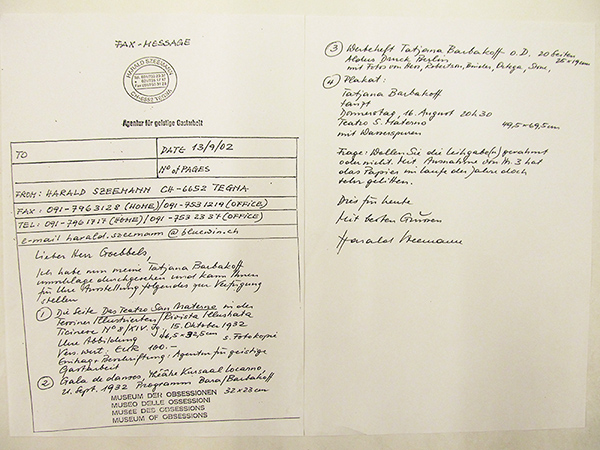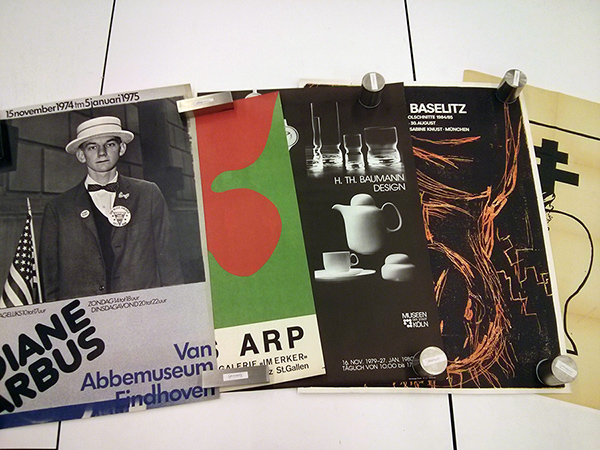
Installation photograph of the exhibition Monte Verità: The Breasts of Truth, including posters promoting performances by Tatjana Barbakoff and Charlotte Bara, 1978, photographer unknown. The Getty Research Institute, 2011.M.30
Swiss curator Harald Szeemann (1933–2005) was an avid collector of posters. When the Getty Research Institute acquired the Harald Szeemann Archive and Library, it arrived with more than 1,200 unfiled posters—not counting duplicates—that Szeemann had collected throughout his career. Similar to the ways in which posters provided visual commentary in Szeemann’s exhibitions such as Science Fiction in 1967 and Monte Verità: The Breasts of Truth in 1978, these posters in his archive have the potential to reveal and represent a history of modern and contemporary art.
1,200 Posters

Three posters from Szeemann’s projects: 12 Environments (1968), signed by Christo; Documenta 5 (1972), designed by Edward Ruscha; and The Tendency towards the Gesamtkunstwerk (1983), designed by Markus Raetz. The Getty Research Institute, 2011.M.30
The bulk of this unfiled collection contains a spectrum of sizable posters promoting modern and contemporary art exhibitions in postwar Europe. One will find posters that accompanied over one hundred of Szeemann’s exhibitions, from 1961’s Otto Schumi at Kunsthalle Bern to 2004’s The Joy of My Dreams in Seville. The exhibition posters outside of Szeemann’s oeuvre cover many celebrated and marginal artists from the twentieth century, especially those with whom the curator had enduring collaborations, including Joseph Beuys, Mario Merz, Michelangelo Pistoletto, and Cy Twombly.
Posters from Kunsthalle Bern and Kunsthaus Zurich, where Szeemann exercised his visionary reign as director and “permanent freelance curator,” respectively, are well represented in the collection. Additional gems include rare posters of performances, protests, and various events that Szeemann deemed momentous, such as posters of performances by Charlotte Bara and Tatjana Barbakoff that were exhibited at Monte Verità.

Fax from Szeemann to Günter Goebbels regarding lending a poster advertising a Tatjana Barbakoff performance at Teatro San Materno to Goebbels’s exhibition about the dancer. The Getty Research Institute, 2011.M.30
What Would Szeemann Do?

Unfiled posters in Szeemann’s archive, the fabbrica rosa, in Maggia, Switzerland.
Before the Getty Research Institute acquired the collection, most of the posters were sprawled across Szeemann’s archive in Maggia, Switzerland. The more valuable ones were locked in flat file drawers, but there was no sense of unity or coherent order. The special collections team faced a challenge: how would Szeemann have organized the posters?
The unfiled posters initially seemed to be separate from the rest of the archive, but we soon discovered a connection while processing the Project and Artist series. The team found many folded posters of similar subject matter filed among Szeemann’s exhibition and artist files. By tracing Szeemann’s method for organizing the folded posters, the staff developed four main categories to classify all of the unfiled posters. Each one is linked to a respective series within the curator’s archive:
- Exhibitions curated by Szeemann. These posters are filed chronologically in Series I under the project name.
- Solo artist exhibitions not directly associated with Szeemann. These works are filed in Series II under the artist’s name.
- Group exhibitions not directly associated with Szeemann. These posters will be filed in Series VII among other institutional ephemera according to the city or institution where the event took place.
- Topical posters (e.g., cinema, anarchism, etc.) will be filed in Series VI under the topic name.

Some exhibition posters interfiled into Series II (from left to right): Diane Arbus, Hans Arp, H. Th. Baumann, Georg Baselitz, and Atelier Populaire. The Getty Research Institute, 2011.M.30
The process of integrating the unfiled posters into the existing series—rather than creating a separate series for them—maintains the distinct arrangement system established by Szeemann, which aligns with the archival principle of original order. The online finding aid was also updated to indicate which files include posters, allowing researchers to easily discover and retrieve these materials.
Reverse-Rolling

Staff used the reverse-rolling method to flatten curled posters.
The special collections team next turned their attention to preservation. With guidance from the Getty Research Institute’s Conservation Department and vital help from graduate intern Lindsey Sommer, we safely flattened hundreds of curled posters on robust paper using a reverse-rolling technique to apply gentle pressure over time. Once returned to their original flatness, the posters were transferred into archival flat files, which provide enhanced preservation and ease of handling and viewing.

The flattened posters are stored in archival flat files
Qualified researchers can now access the oversize posters in Series I and II, and the posters in Series VI and VII will be available once the cataloguing and preservation process is complete.

See all posts in this series »




Comments on this post are now closed.